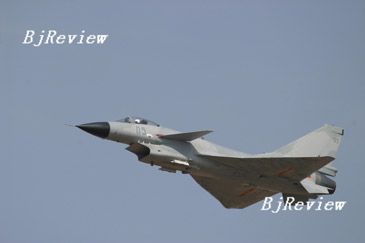
Chen Zhou, a noted researcher with the Warfare Theory and Strategy Research Department of the Academy of Military Sciences of the Chinese People's Liberation Army of China, analyzes the 2006 white paper on China's national defense in an exclusive interview with People's Daily. Excerpts follow:
People's Daily: The newest white paper on China's national defense is the fifth of its kind the Chinese Government has issued since 1998. Could you tell us what are the most salient features of this year's white paper?
Chen: The new white paper focuses on new changes in the international security situation, China's defense policy and progress made in developing the national defense and army in the past two years.
Its most salient features are as follows:
First, it fully embodies the basic concept of China's national defense policy to maintain peaceful development. This is in line with China's basic national policy to take the road of peaceful development, to build a harmonious society at home and to promote the building of a harmonious world.
Second, it gives prominence to the all-round, coordinated and sustained development of the national defense and armed forces.
Third, it increases the transparency of China's defense policy and strategic intention. The purpose in increasing such transparency is to build up mutual confidence between nations. The new white paper enunciates in an open way many aspects with regard to the judgment of security environment, security strategic concepts, as well as the country's defense policy and military strategy.
What changes are represented in this white paper?
Another four chapters-China's Leadership and Administration System for National Defense, The People's Liberation Army, People's Armed Police Force and Border and Coastal Defense--are added to the new white paper, and an additional chapter on defense expenditure is offered with an explicit aim to further increase the transparency of the national defense and armed forces.
On the exposition of China's national defense policy, the new white paper for the first time presents China's self-defensive nuclear strategy. That is, China remains firmly committed to the policy of no first use of nuclear weapons at any time and under any circumstances, it upholds the principles of counterattack in self-defense and limited development of nuclear weapons and it aims at building a lean and effective nuclear force capable of meeting national security needs and maintains a credible nuclear deterrent force.
The new white paper also releases for the first time China's goal for a three-step development strategy in modernizing the national defense and armed forces: The first step is to lay a solid foundation by 2010, the second is to make major progress by 2020 and the third is to basically reach the strategic goal of building hi-tech armed forces and being capable of winning modern wars by the mid-21st century.
The 2002 and 2004 white papers are devoted to a description of the security situation both at home and abroad in their first chapter, and the white paper this year has again set aside space for the same purpose. What differences do the new white paper have with the previous white papers in terms of its description and judgment of the security situation?
| 